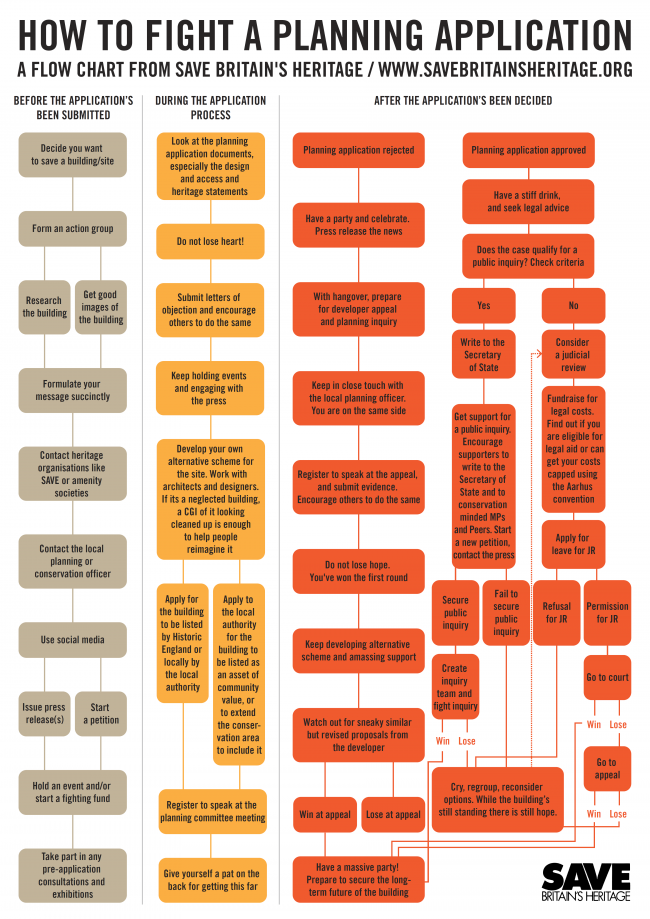The Campaign
The Campaign
Two questions you will constantly be asked are: What can be done with the old wreck, what will it cost and won't it be a waste of taxpayers' money?
It is not essential to be able to answer these questions immediately. In your initial blast, concentrate on the building's importance and interest, and the immediacy of the threat.
SAVE has produced a flowchart for how to fight a planning application. Please see below for more detailed information.

Getting professional advice
Very often the developers will produce figures showing that the building would be impossibly expensive to restore. In addition, there may be statements from engineers or surveyors suggesting that the buildings is physically unsound.
These must be challenged or rebutted. Today there are very few old buildings so structurally unsound that they cannot be saved. Many so called 'expert reports' simply provide the answers sought by those who commissioned them.
You must therefore find an architect, engineer or surveyor who has experience of old buildings and can provide an alternative, independent view. In many cases, the national societies can suggest local professionals who will be willing to help, sometimes on a voluntary basis.
Raising a fighting fund
Try to establish a basic float by persuading friends and well-wishers to contribute a few pounds: £20, £30 or £50 should be sufficient. SAVE itself was started with little more than £300, with initial committee members each putting in £10.
Try to obtain free services wherever possible, but having a small float helps morale and helps leverage in further support.
Engaging with Social Media
This is one of the best ways to get your message out. Set up a Facebook page and invite people to join it, set up a Twitter account and start connecting with other groups either in your area or nationwide who may support your cause. There are other options such as Instagram. This helps consolidate support.
Petitions
The more public support you can demonstrate, the stronger your case will be. Petitions raise public awareness and the press is always interested in hard statistics; so if you can say several hundred people signed the petition over the course of a few days it will undoubtedly earn you publicity.
Of course there will always be some people who say, 'People will sign anything', and deride your efforts. Point out that this is an extremely undemocratic and elitist attitude, particularly if it comes from public figures.
There are several good platforms for petitions, including 38 Degrees and Change.org. Their websites have excellent guidelines for setting up a petition. As with all aspects of campaigning, a good picture is essential, so that those signing understand what it is they are fighting for. Also, establish who you are petitioning – the Secretary of State (if it is for a Public Inquiry, see elsewhere in this guidance for more details), the property owner, the head of the local authority making the decision, the Mayor? And ensure your message is succinct – do not try and tell the entire story in the petition – you will lose people’s interest. Keep it simple.
You must be sure to avoid contentious or complicated wording, which might deter people, and choose a clear simple message, such as 'The Congleton Arms is a building of historic interest and deserves to be preserved as part of the town's heritage.’
One of the other great things about a petition is that you have a body of people who you can keep updated and call upon for support. This list will not be given to you by petition provider; they guard the privacy of signatories, but you are able to send out messages to them. SAVE has found this extremely useful in many campaigns.
